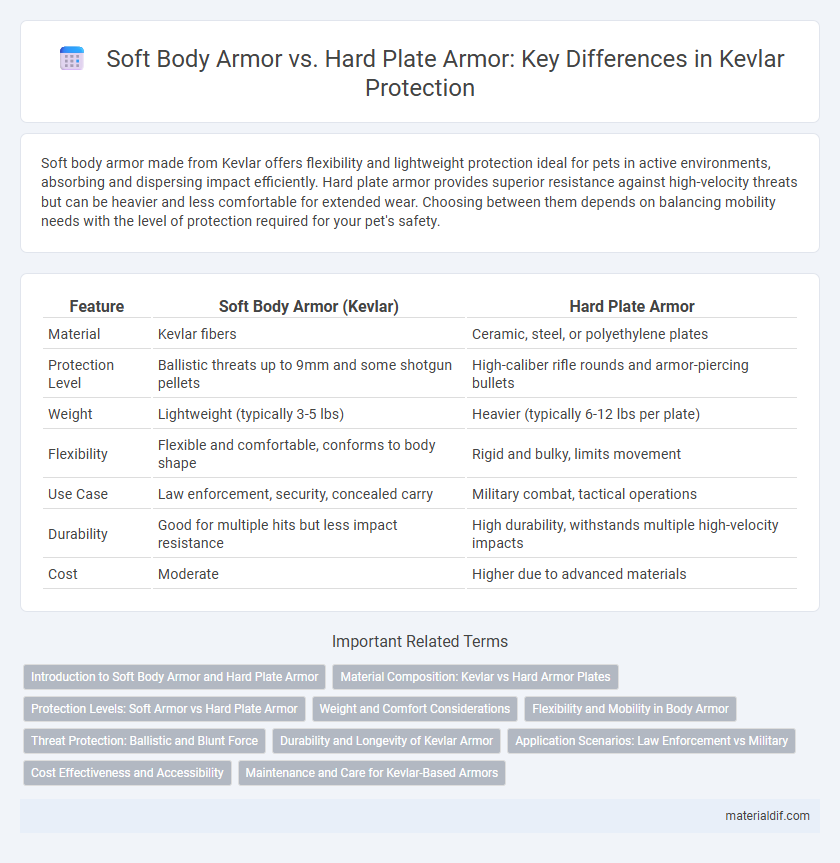Soft body armor made from Kevlar offers flexibility and lightweight protection ideal for pets in active environments, absorbing and dispersing impact efficiently. Hard plate armor provides superior resistance against high-velocity threats but can be heavier and less comfortable for extended wear. Choosing between them depends on balancing mobility needs with the level of protection required for your pet's safety.
Table of Comparison
| Feature | Soft Body Armor (Kevlar) | Hard Plate Armor |
|---|---|---|
| Material | Kevlar fibers | Ceramic, steel, or polyethylene plates |
| Protection Level | Ballistic threats up to 9mm and some shotgun pellets | High-caliber rifle rounds and armor-piercing bullets |
| Weight | Lightweight (typically 3-5 lbs) | Heavier (typically 6-12 lbs per plate) |
| Flexibility | Flexible and comfortable, conforms to body shape | Rigid and bulky, limits movement |
| Use Case | Law enforcement, security, concealed carry | Military combat, tactical operations |
| Durability | Good for multiple hits but less impact resistance | High durability, withstands multiple high-velocity impacts |
| Cost | Moderate | Higher due to advanced materials |
Introduction to Soft Body Armor and Hard Plate Armor
Soft body armor, typically made from Kevlar fibers, offers lightweight, flexible protection designed to absorb and disperse the energy from handgun rounds and shrapnel. Hard plate armor incorporates rigid ballistic plates often composed of ceramic, polyethylene, or metal materials, providing enhanced defense against high-velocity rifle rounds and armor-piercing threats. Selecting between soft body armor and hard plate armor depends on the balance required between mobility, comfort, and the level of ballistic protection needed in various operational environments.
Material Composition: Kevlar vs Hard Armor Plates
Kevlar, a synthetic fiber known for its high tensile strength-to-weight ratio, is the primary material in soft body armor, offering flexibility and lightweight protection against ballistic threats. In contrast, hard armor plates utilize rigid materials such as ceramic, steel, or polyethylene composites, providing enhanced resistance to high-velocity rifle rounds but at the cost of increased weight and reduced mobility. The combination of Kevlar's woven layers in soft armor and the dense, impact-dispersing properties of hard plates creates a tiered defense system optimized for different combat scenarios.
Protection Levels: Soft Armor vs Hard Plate Armor
Soft body armor made from Kevlar offers effective protection against handgun rounds and low-velocity threats, classified under NIJ Levels II and IIIA, while maintaining flexibility and comfort. Hard plate armor, often composed of ceramic or metal plates combined with Kevlar backing, provides superior defense against rifle rounds and high-velocity projectiles, meeting NIJ Level III and IV standards at the expense of increased weight and reduced mobility. Choosing between soft armor and hard plates depends on the expected ballistic threat and operational requirements for balance between protection and agility.
Weight and Comfort Considerations
Soft body armor made with Kevlar offers a lightweight and flexible option, significantly enhancing comfort and ease of movement for extended wear. Hard plate armor, while providing superior ballistic protection, is considerably heavier and less comfortable, potentially restricting mobility during prolonged use. The choice between soft Kevlar vests and hard plates hinges on balancing protection needs with comfort and weight tolerance in operational scenarios.
Flexibility and Mobility in Body Armor
Soft body armor made with Kevlar offers superior flexibility and enhanced mobility, allowing wearers to move more freely during physical activities or combat situations. In contrast, hard plate armor provides greater protection against high-velocity projectiles but significantly reduces flexibility due to its rigid structure. Kevlar's woven fibers enable soft armor to deliver lightweight, flexible defense, making it ideal for scenarios demanding agility and prolonged wear.
Threat Protection: Ballistic and Blunt Force
Soft body armor made from Kevlar excels at dispersing the energy from ballistic threats such as handgun rounds by trapping and deforming the projectile fibers without penetration. Hard plate armor, often composed of ceramics or metal alloys, provides superior blunt force protection against rifle rounds and high-velocity impacts by preventing projectile penetration and absorbing shock. Combining Kevlar soft armor with hard plates enhances overall threat protection by balancing flexibility and resistance to both ballistic and blunt force trauma.
Durability and Longevity of Kevlar Armor
Kevlar soft body armor offers superior flexibility and comfort but tends to have a shorter lifespan due to fiber degradation from moisture and UV exposure. Hard plate armor, often incorporating Kevlar layers with ceramic or polyethylene plates, provides enhanced durability and multi-hit resistance, extending overall armor longevity. Regular maintenance and proper storage are critical for maximizing the durability and protective lifespan of Kevlar-based armor systems.
Application Scenarios: Law Enforcement vs Military
Soft body armor made from Kevlar is widely used by law enforcement officers for its flexibility and comfort during extended patrols and urban operations, providing effective protection against handgun rounds and shrapnel. Hard plate armor, often incorporating ceramic or composite plates alongside Kevlar, is preferred by military personnel operating in high-threat combat zones due to its superior ballistic resistance against rifle rounds and explosive fragments. Law enforcement prioritizes mobility and concealability, while military applications demand maximum protection in diverse, high-intensity environments.
Cost Effectiveness and Accessibility
Soft body armor made of Kevlar offers greater cost effectiveness and accessibility due to lower manufacturing expenses and lighter materials compared to hard plate armor. Kevlar vests typically cost a fraction of the price of ceramic or steel plates, making them more affordable for law enforcement and civilian use. The widespread availability and ease of distribution of soft armor enhance its accessibility in various markets and regions.
Maintenance and Care for Kevlar-Based Armors
Kevlar-based soft body armor requires meticulous maintenance, including regular inspection for tears, discoloration, and water damage to preserve its ballistic integrity. Hard plate armor with Kevlar backing demands thorough cleaning and drying, ensuring no moisture compromises the Kevlar layers, as prolonged exposure can degrade its protective capabilities. Proper storage in a cool, dry environment extends the lifespan of both armor types, preventing material fatigue and maintaining readiness.
Soft Body Armor vs Hard Plate Armor Infographic

 materialdif.com
materialdif.com